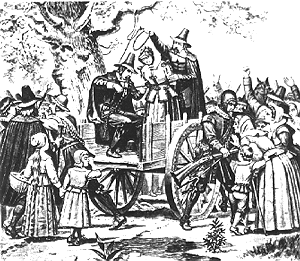Execution Chronology
In seventeenth-century New England, those suspected or accused of witchcraft did not always end up in court. Some suspected incidents were discretely contained within the household or local community and handled by ministers without legal intervention. Moreover, not all trials led to convictions, and not all convictions were punished by death. Salem Witchcraft was distinctive in its rapid and extensive resort to legal institutions. An accusation generally involved a complaint made before civil officials, resulting in an arrest warrant and examination before magistrates. The magistrates' questioning was often interrupted by outbursts by afflicted accusers, mostly young women, who claimed to be tormented by specters of the accused, presumably at their behest. Other witnesses, often neighbors of the accused, presented stories of harmful occult behavior, some recent, some occurring years before. The magistrates then determined whether, in light of this evidence, the accused should be released (rare) or held to appear before a grand jury. If the grand jury determined on an indictment, the accused faced a jury trial and, if found guilty, a sentence of execution by hanging.
In May 1692, as examinations and jailings escalated, Sir William Phips arrived in Massachusetts as its first royal governor under a new charter. Phips quickly established a special Court of Oyer and Terminer to decide the cases of those arrested for witchcraft. The court consisted of a number of judges, whom Phips considered to be "of the best prudence and figure" available. It was presided over by William Stoughton, the colony's new lieutenant governor. Unlike the earlier examinations, a jury was constituted to hear these cases. Those found guilty were sentenced to death for committing a capital crime.
As with Salem's accusations, histograms can display the distribution of executions over the course of the Salem episode. Using the "Month of Execution" column in the Accused Histogram Data Set (or in the larger Accused Witches Data Set), a histogram of executions can be constructed. In Excel, go to the Tools Menus and "Data Analysis" and then "Histogram." For "Input Range," drag the mouse to select all the data cells of the "Month of Execution" column. Perform the same procedure for "Bin Range," selecting the data cells in the "Bin" column. In the "Histogram" window, choose "New Worksheet Ply," "Chart Output," and "Label." The resulting histogram can be resized and relabeled using the "Chart Options" in the Chart Menu.
To view the execution histogram and assess its significance, click Next.
